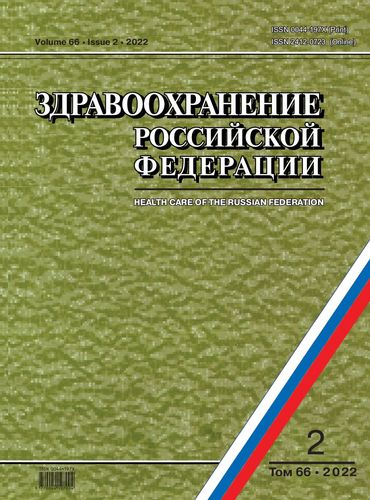Comparative analysis of the infant mortality rate in the Russian Federation and the Privolzhsky Federal District over 1999–2018
- 作者: Ananin S.A.1, Karpova S.S.1
-
隶属关系:
- Privolzhsky Research Medical University
- 期: 卷 66, 编号 2 (2022)
- 页面: 131-137
- 栏目: CHILDREN AND ADOLESCENTS’ HEALTH
- ##submission.dateSubmitted##: 25.10.2024
- URL: https://vestnik.nvsu.ru/0044-197X/article/view/637768
- DOI: https://doi.org/10.47470/0044-197X-2022-66-2-131-137
- ID: 637768
如何引用文章
全文:
详细
Introduction. The infant mortality (IM) rate is a serious medical, social and demographic problem. This is one of the main indicators of public health, which characterizes not only the quality of the medical and preventive care for women and children, but also the level of socio and economic well-being.
The purpose of the study was to investigate the trend in IM indicators in the Privolzhsky Federal District (PFD) and the Russian Federation (RF) over a twenty-year period (1999–2018) and to determine the relationship with the indicators of gross domestic product (GDP).
Material and methods. The analysis of official statistical data is carried out and the comparison of regional indicators with the national average values and data for a number of countries of the world is carried out. The paper uses statistical and analytical methods. The correlation between IM, total mortality and the gross regional product (GRP) per capita in the Privolzhsky Federal District and GDP per capita in the Russian Federation is carried out.
Results. Over the past 20 years, both in the Privolzhsky Federal District and in the Russian Federation, a decrease in the IM rate value was found to be registered by more than 3 times. There is a strong negative relationship between IM rate and GRP per capita in the Privolzhsky Federal District and IM rate and GDP per capita in the Russian Federation.
Limitations. The analysis of infant mortality in the territory of the Privolzhsky Federal District and in the Russian Federation for a 20 years was carried out using a continuous method according to official statistical reports, which is a sufficient reference sample.
Conclusion. Without reducing the IM rate in all subjects and districts of the Russian Federation, it is impossible to achieve its reduction in the country as a whole. The main tool for achieving this goal is the implementation of the National Project “Health Care”, which provides, among other things, the reduction of IM. At the same time, IM indicator in Russian Federation was already less than the indicator value of 2020 in 2018, and its value in the Privolzhsky Federal District reached the planned level of 2022. Thus, the final indicator of the National Project is not only achievable, but can also be adjusted in the process of its implementation.
Contribution of the authors:
Ananin S.A. — research concept and design, collection and processing of material, writing the text, statistical data processing, editing.
Karpova S.S. — collection and processing of material, writing the text, compilation of the list of literature, statistical data processing, editing.
All authors are responsible for the integrity of all parts of the manuscript and approval of the manuscript final version.
Acknowledgment. The study had no sponsorship.
Conflict of interest. The authors declare no conflict of interest.
Received: January 31, 2021
Accepted: February 16, 2021
Published: May 04, 2022
作者简介
Sergey Ananin
Privolzhsky Research Medical University
编辑信件的主要联系方式.
Email: ananyin.sergey@mail.ru
ORCID iD: 0000-0003-2080-3065
MD, PhD, DSci, Professor of the Department of Social Medicine and Public Health Organization, Privolzhsky Research Medical University, Nizhny Novgorod, 603005, Russian Federation.
e-mail: ananyin.sergey@mail.ru
俄罗斯联邦Svetlana Karpova
Privolzhsky Research Medical University
Email: noemail@neicon.ru
ORCID iD: 0000-0002-2621-7641
俄罗斯联邦
参考
- Baranov A.A., Al’bitskiy V.Yu., Namazova-Baranova L.S., Terletskaya R.N. The State of Children’s Health in Modern Russia [Sostoyanie zdorov’ya detey sovremennoy Rossii]. Moscow: Pediatr; 2020. (in Russian)
- Ivanov D.O., Aleksandrovich Yu.S., Orel V.I., Prometnoy D.V. Infant mortality in Russian Federation and influence on its dynamic factors. Pediatr. 2017; 8(3): 5–14. https://doi.org/10.7256/2585-7797.2020.3.33356 (in Russian)
- Baranov A.A., Al’bitskiy V.Yu. Mortality of the Russian Child Population (Trends, Causes and Ways of Reduction) [Smertnost’ detskogo naseleniya Rossii (tendentsii, prichiny i puti snizheniya)]. Moscow: Soyuz pediatrov Rossii; 2009. (in Russian)
- Lisitsyn Yu.P. Public Health and Health Care: Textbook [Obshchestvennoe zdorov’e i zdravookhranenie: uchebnik]. Moscow: GEOTAR-Media; 2010. (in Russian)
- Shchepin O.P., Korotkikh R.V., Shchepin V.O., Medik V.A. Public Health is the Basis for Health Care Development [Zdorov’e naseleniya – osnova razvitiya zdravookhraneniya]. Moscow; 2009. (in Russian)
- Baranov A.A., Albitskiy V.Yu., Namazova-Baranova L.S. Child mortality in Russia: situation, challenges and prevention aims. Voprosy sovremennoy pediatrii. 2020; 19(2): 96–106. https://doi.org/10.15690/vsp.v19i2.2102 (in Russian)
- Baranov A.A., Namazova-Baranova L.S., Al’bitskiy V.Yu., Terletskaya R.N. Tendencies of infantile and child mortality in the conditions of implementation of the modern strategy of development of health care of the Russian Federation. Vestnik Rossiyskoy akademii meditsinskikh nauk. 2017; 72(5): 375–82. https://doi.org/10.15690/vramn867 (in Russian).
- Demographic Yearbook of the Russian Federation [Demograficheskiy ezhegodnik Rossiyskoy Federatsii]. Moscow: Rosstat; 2000–2019. (in Russian)
- Albitskiy V.Yu., Terletskaya R.N. Infant Mortality in the Russian Federation in the Context of New Requirements for Birth Registration [Mladencheskaya smertnost’ v Rossiyskoy Federatsii v usloviyakh novykh trebovaniy k registratsii rozhdeniya]. Moscow: Pediatr”; 2009. (in Russian)
- Kvasha E.A. Mortality of children under 1 year old in Russia: what has changed after the transition to the new definition of live birth and stillbirth. Demograficheskoe obozrenie. 2014: (2): 38–56. (in Russian)
补充文件








